The issue of SHOTS magazine current at the time of this writing contains images central to my thesis: Recovered slides from my grandfather’s collection. On the off-chance you missed it, I’ll reproduce them below.
These were shot in the late 1940s using my grandfather’s Argus C3, the original 35mm compact, so it was a stretch convincing the editors of SHOTS that I, born in the 1980s, am “the creator of these original photographs,” as the submission form requires you to attest. I did indeed check the attesting box, even though I’m clearly not the creator of the images as they were originally intended. But I wrote a little note to the editors–we know each other well because they reject me almost every quarter–arguing that the images as they exist today are actually the creation of decades of improper storage, in which I certainly had a hand.
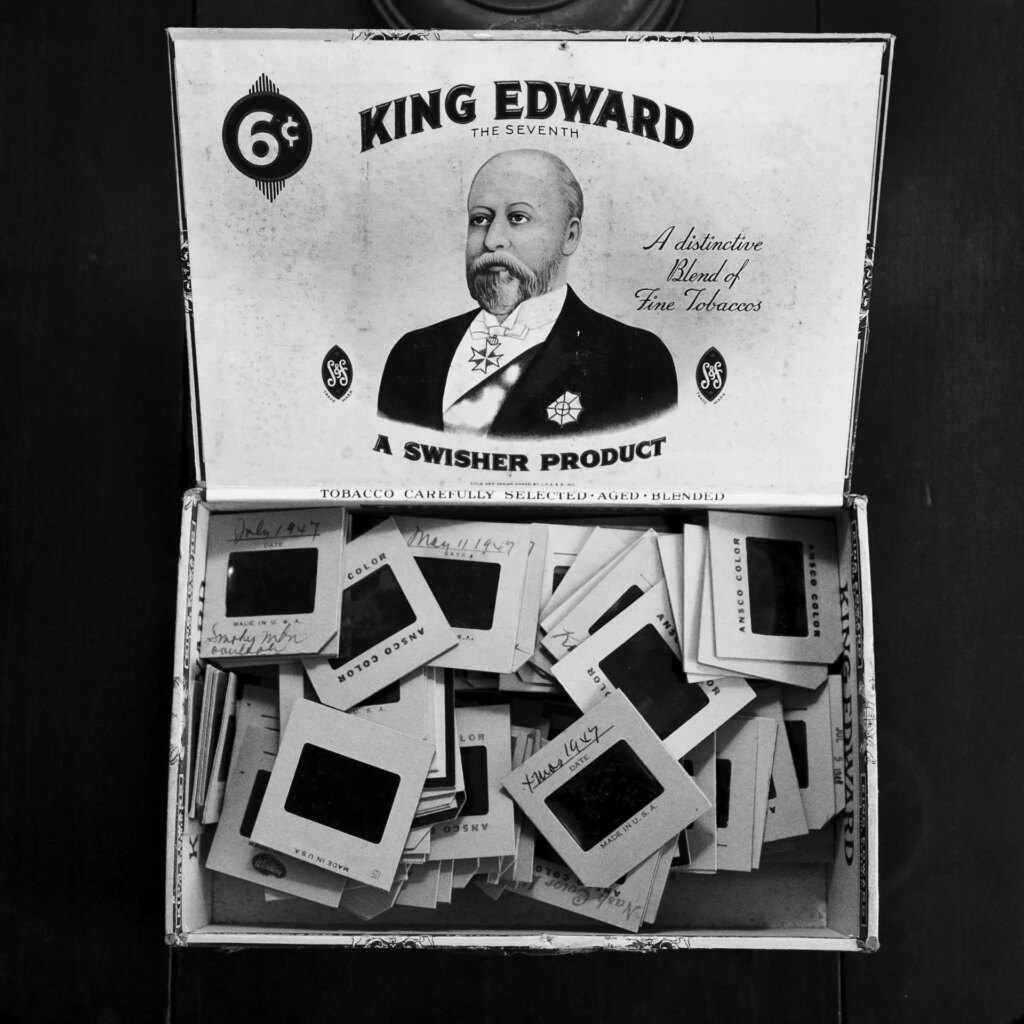
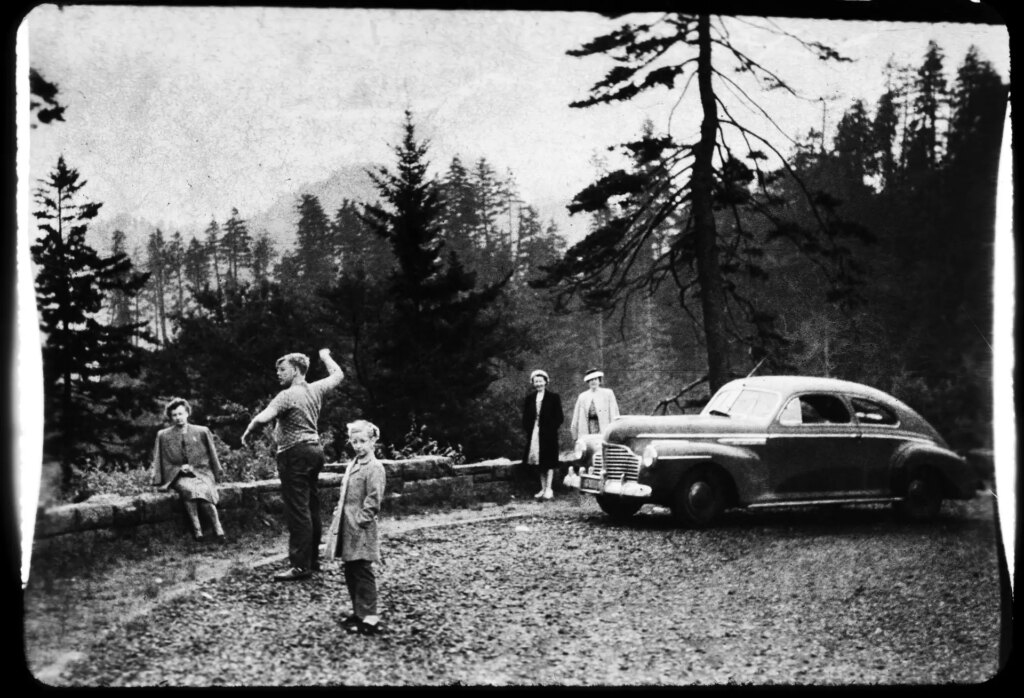
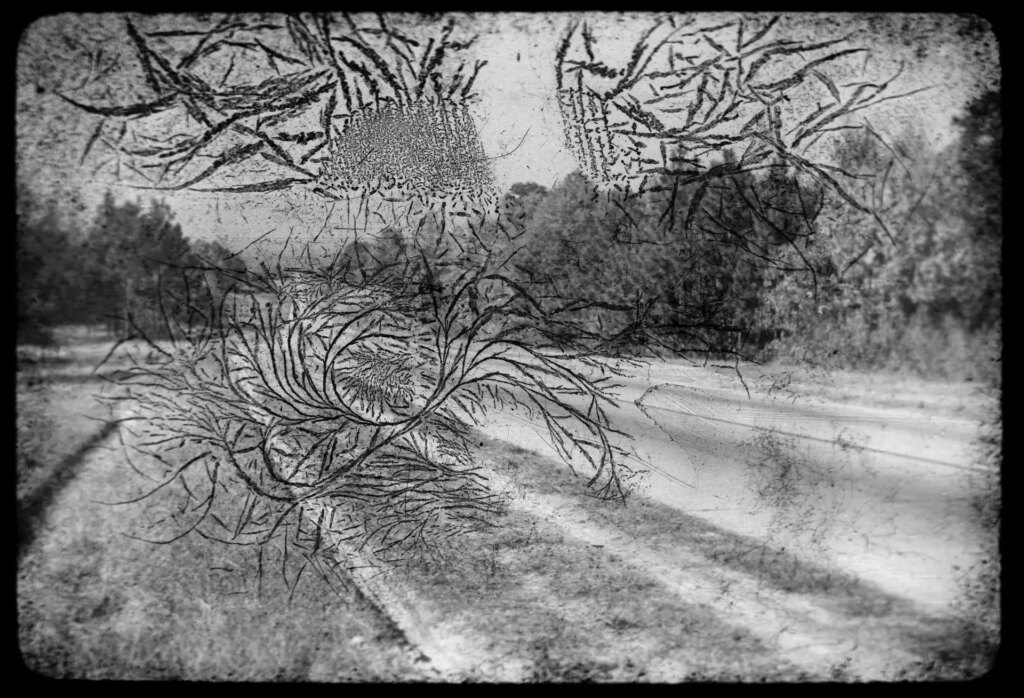
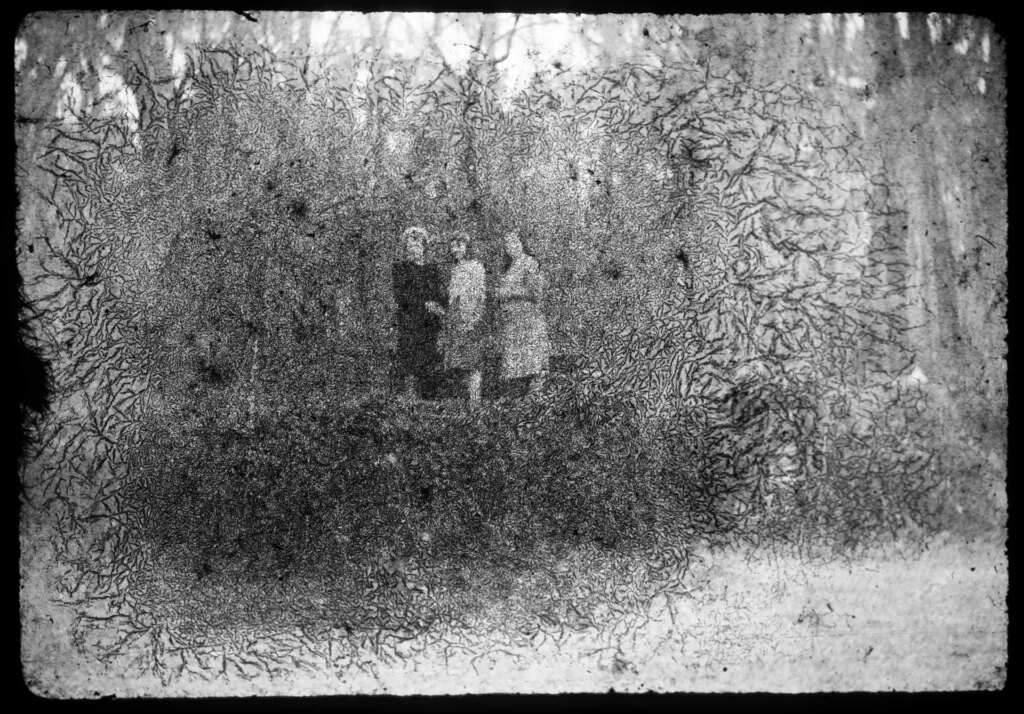
“My belief,” I wrote, drawing from my years in art school, where they train you to bullshit like this when your case isn’t very strong, “is that the dramatic fungal etching is as much a creator of these images as my grandfather or I have been.”
Setting aside the fact that an indy photo rag probably isn’t concerned with being sued by my long-dead grandfather, I like to think I argued a cogent philosophical point that the editors discussed in the editor’s lounge at the end of the day: The idea that an image can be so eroded by time that it becomes more a product of our apathy and disuse than of its creator’s vision and skill. Isn’t that fascinating?
No. It’s not. I’d rather just have some nice pictures of my loved ones.
The Neo-Analogger
I’m not a therapist, but I am a photographer who’s seen enough therapists to know that photographers are a therapist’s job security. Every last one of us is a raging narcissist. Our entire ethos runs counter to the way of the universe: We are driven solely by a yearning ache for permanence manifested in reductive visual terms. Personally offended by ephemerality, we combat it by hoarding images. To hold on to the nuanced depth of life, we record declarative evidence of what one-fifth of our senses experience in any irretrievable moment.
Who are we to blunt time’s arrow? Photographers, that’s who. Not only are our eyes trained to acutely witness the viscera, our skills are honed to capture it. And, most importantly: We have purchased the correct equipment with which to capture it.
This last part is our undoing. My grandfather scraped by with his Argus C3, but us? No my friends, our vision is worth so much more. Many megapixels more, usually captured in the deepest bit-depths of raw sensor information after that sensor has been exposed using an automatic calculus literally based on man’s total knowledge of photography thus far. And the LENSES! Perfectly formed glass sculpted by deep-learning computer models. Eff-one-two! Why, that Argus didn’t even have ONE megapixel, and have you seen its awful bokeh? I guess my grandfather didn’t really love his family.
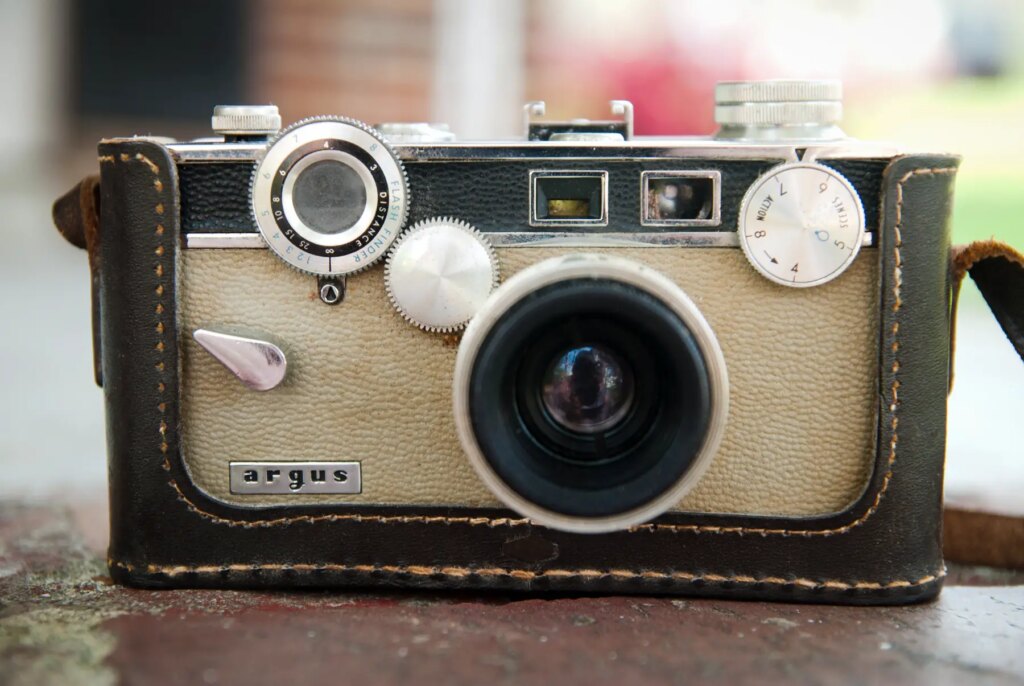
But we all see the flaws in this logic. Good photography is about communication, not technical perfection.
Fortunately for culture, a new type of photographer has lately arisen, one who rejects the hubris of mainstream photography. How do we know? Because he’ll tell you. I’m talking, of course, about the Neo-Analog Photographer. And I can speak with authority, because I am one.
No tech-driven sensor slapper, the Neo-Analogger doesn’t chase the latest and greatest. Did you know that sharpness is a bourgeois concept? He knows. He forges the future as a return to the past. And the big camera manufacturers don’t have him in their pockets. By the way, did you hear Leica re-released the M6? Or you could just get one on eBay. Mint condition “for its age!” EXC+++++!
It’s not about the money. It’s about timelessness: Digital cameras obsolete (that’s a verb now) after every blog post on DPreview, but Neo-Analoggers buy cameras “for life,” to “support film,” and when our brief flash is fading and our arthritic fingers become too old to participate in the joy of fine mechanical engineering, these heirlooms will be “passed on to our children.”
You know, like my grandfather’s slides.
The Tell-Tale Negatives
Let’s hope our cameras appreciate, because any shred of our childrens’ inheritance we save by eschewing Big Digital is frittered away feeding our cameras film. And then developing it. And then scanning it. And then–here’s the crux–storing it for posterity.
It’s the posterity that gets you. It’s no coincidence that “posterior” is a colloquialism for “your ass,” because that’s basically where we put things when we save them for posterity. But in my case, I stored my negatives behind the fridge.
Before I was a Neo-Analogger, I was just an Analogger, or, as we called ourselves in those days, a photographer. In the early years my negatives–thousands and thousands of them–lived in a drawer. When they outgrew the drawer, they got their own plastic bin. Over the years, the bin has been upgraded. It has occupied several stations, including under the bed, the top shelf of the closet, and a brief stint in the attic. At one point I took all the binders out of the bin and filled the bottom two drawers of my dresser. But then I had nowhere to put my laundry, so it heaped on the floor as a habitat for mice.
And that’s just the “serious” monochrome work. The C41 negatives were improperly stored in their original drugstore envelopes in a shoe box. And then two shoe boxes. And then . . .
And then one day while repairing the refrigerator that, like my grandfather’s slides, had reached a new form through apathy and disuse, I realized there was a good six square feet of space behind it in the, uh, fridge hole. I don’t know what this space originally was, but it was empty now, and I hastily shoved in my bins and shoeboxes and huffed and puffed until the fridge was back in place. My life’s work was safe, and when I needed my negatives–when the day came that I remembered a real Pulitzer-winner in there and, with all the free space in my house, built a darkroom to print it–they would be only a fridge away.
That was twelve years ago.
And they would still be in the fridge hole had it not been for the COVID lockdowns. With nowhere to store our newly-hoarded toilet paper dry goods and medical supplies, I was forced to exhume my negatives to make room. As the clock slowly marked the creeping seconds of quarantine, the bins and shoeboxes towered in the middle of my office. Like a Poe-esque addition to all the other horrors of the time, my past had literally become a presence in the room, watching over my shoulder as I browsed r/analog.
And what do Poe’s characters do when the unemtombed past comes a-haunting? They try their best to kill it.
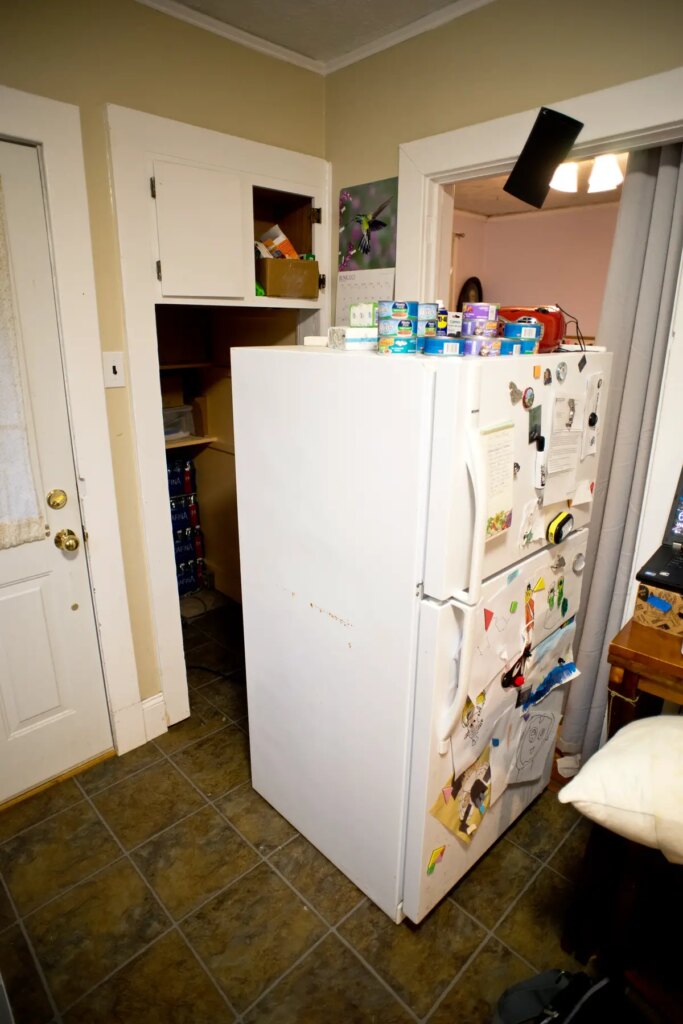
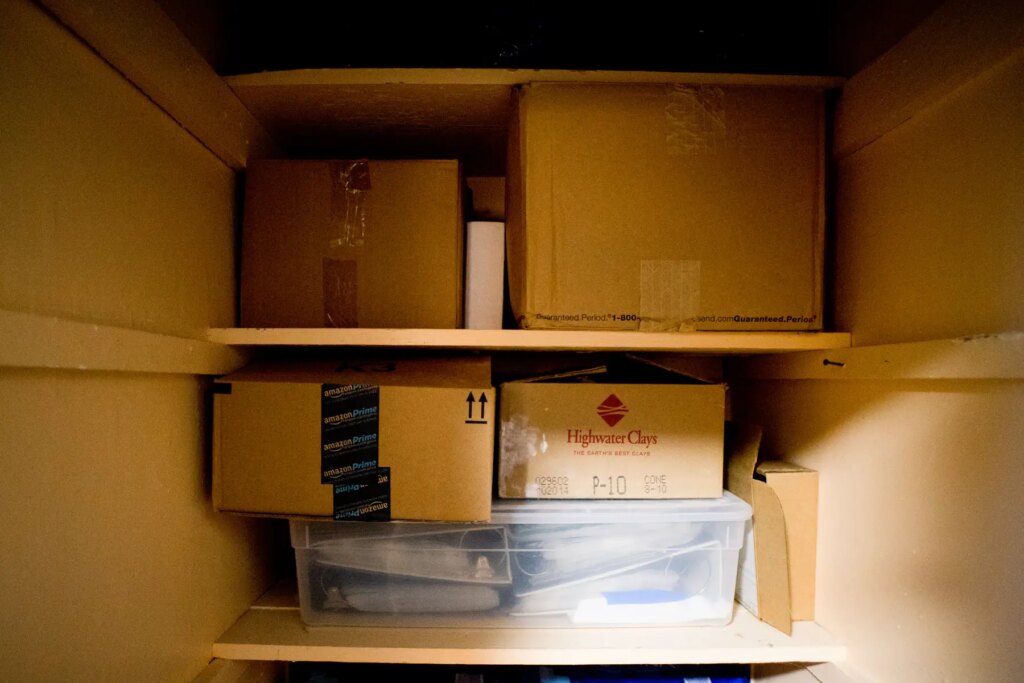
Scan and Destroy
With the enthusiasm that can only be inspired by a quarantine project, I set about my gruesome task. But, observing the primary rule of Neo-Analogism, I never do anything without first announcing it on social media. The idea was simple: I would make a final, high-quality scan of each negative, and then destroy it. I accompanied this announcement with a picture of my negatives in the trash.
The reaction was immediate and frothy. Scores of other Neo-Analoggers who had never once commented on my photos were now adamant that I preserve their truest form. Photographers I’d never heard of sent me emails offering to store my negatives at their own expense until the day I came to my senses and begged for their return. A thousand hipsters took a break from proclaiming that analog photography is “all about the process” and suddenly became very offended that I might bin the product.
As an overweight middle-aged man, I don’t often see rewards from attention-seeking behavior. Invigorated, I doubled down: Not only would I destroy the negatives, I would save the scans… as JPEGs! Both of my Instagram followers lost their beanie-clad minds.
But as I patted myself on the back for stirring the pot, I was left with the question. The negative is sacrosanct. It is, as Ansel Adams said, the score–virgin imagery, unsullied by digitization or enlargement; the archival, unequivocal, unadulterated record of light that passed through our lens at a specific moment in our lives. Was I actually going to destroy them?
Well, no, but not for lack of trying. It’s been two years, and I’ve made it through approximately 10% of my negatives. Not to mention my father’s and grandfather’s film. Being a self-employed artist, and, it follows, irretrievably broke, I promise my siblings each Christmas that in lieu of actual gifts I will finish our family archive. I’m so excited about the task that I plan to start as soon as I finish this article, which I’ve also been working on for two years.
But the fact that I haven’t completed my destruction isn’t an argument against it. Actually, the monumental weight of this task is the biggest argument in its support.
The What-ifs
Neo-Analog brethren, lean close and I will whisper the truth: The film is not the photograph. It is a byproduct. And elevating a byproduct to the same status as the art itself is detrimental to the art.
Assuming that your digitizing is of excellent quality and your data management is secure, clinging to negatives has the same effect on our photographic souls as clinging to the empty canisters and plastic wrappers our film arrived in. The negative becomes an idol, stored away in the holiest of holies, holding us in its sway but only accessible through arcane rituals. At best this worship is a waste of energy and at worst it’s obsessive hoarding–a grasp for permanence that paralyzes inspiration. Like any other vessel that carries your art, you should honor your negatives… and then let them go.
I can hear you now: But Max, what if–? What if you want to print these images? What if technology improves and you could get more from a future scan? What if technology fails and you lose them altogether? What if!
Let’s get back into therapy: “What if” questions are always raised by anxiety, something in no short supply among people who have sworn a quest against entropy itself. In the past you may have had a point, but today the negative is now far from the best answer to these questions:
What if you want to print your negatives? Easy: You don’t. If you did, you already would have. Setting aside the vanishingly small percentage of Neo-Analoggers who work exclusively in the darkroom, we’re all just cosplaying real analog photographers, who, in these latter days, are either insufferable luddites or artists of such importance that they surely don’t care what I think. And many of those artists destroy their negatives after printing limited editions. For every other instance, just get over yourself and print the scans digitally like a normal person.
What if improved technology can produce a better scan in the future? Well, I’m sure it can. But exactly which improvements are you waiting for? Given my assumption above that your digitizing is of the utmost quality, are you seriously arguing that your photography is so vibrant and organic that it cannot be captured by today’s technology? The vast majority of the most important photographs in the last twenty years are sourced from no negative at all, and when analog photographers as talented and varied as Clyde Butcher and Ralph Gibson have embraced digital workflows, it’s safe to say the technology itself is not the limiting factor for the rest of us.
What if technology fails? It’s true that electronic data failure happens, and that’s why my second stipulation above is secure data management. Nevertheless, governments, financial systems and universities, whose data is all vastly more voluminous and complex than any photographer’s archive, store it electronically. Best practices can be followed and your images can be kept secure.
It is here that the argument plumbs the deepest trenches of our anxiety. Yes, you may say, data can be maintained, but what if–there it is again–there is some unforeseen catastrophe? A nuclear strike, an EMP weapon, or a Carrington-level solar event? Something that disrupts the electric grid so thoroughly that our images are not recoverable?
Well, in that case, the loss of your scans will be the least of your worries. And what if you had kept your negatives? The markets are erased, planes are falling from the sky and medical care has regressed to leeching, but you’re safe at home viewing your Tri-X with a loupe and candlelight?
The converse of this argument, often ignored, is that analog data is far less durable–and that’s why I’m writing this to begin with. It need not be something as dramatic as flood or fire or theft. Film is archival only if it has been properly processed and immaculately stored, and mistakes in these practices are not immediately evident. And that’s why, instead of invaluable pictures of my ancestors, I have fungal etchings fit for artsy photo magazines.
The Bequeathing
The most misplaced of the admonishments I received when I set about scanning and destroying were those from photographers who warned that someday my son would wish I had preserved my film.
I appreciate the sentiment, but the idea that we are “gifting” our negatives to our heirs is so absurd it can only be explained as narcissistic delusion. My kid wouldn’t look away from his iPad if he were swarmed by bees, but I plan to bequeath him a hundred thousand tiny analog pictures that can only be viewed with equipment not produced in decades? Who the hell do I think I am?
Even the most devoted family historians will be grateful for their forebears’ images, but not their film. I am living proof: The third in a paternal line of historians, journalists and photographers, I love old film and cameras and dusty relics. I am a case study in exactly the kind of obsessive nerd who should be enthralled with a trove of film. And what have I done with it? Allowed it to deteriorate for another two years, because I have work to do and a kid to raise. It’s not a gift. It’s a burden.
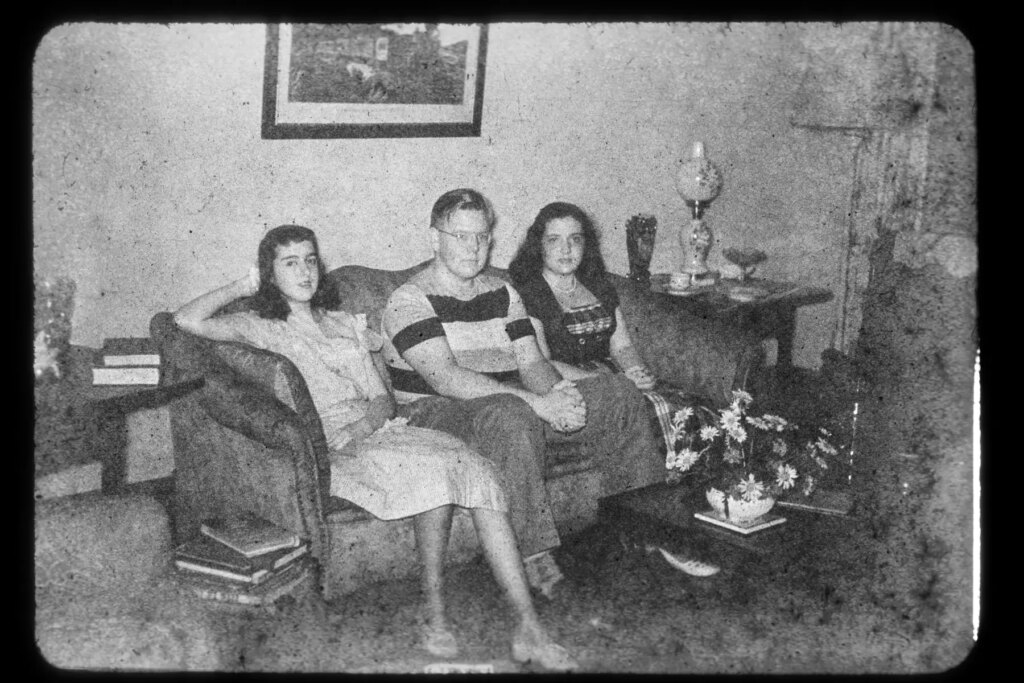
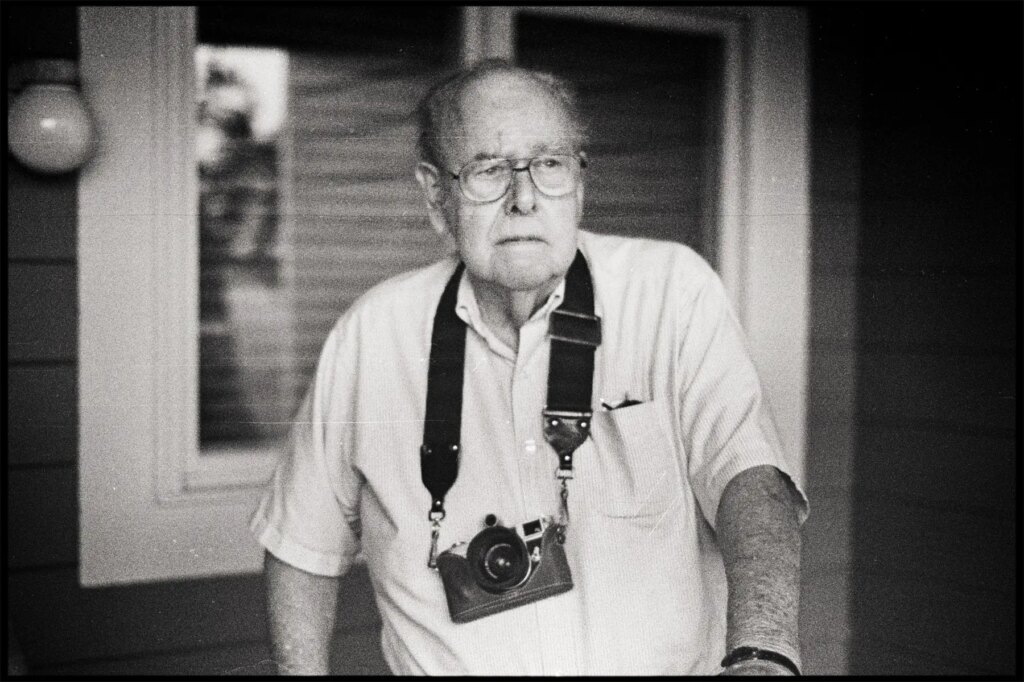
[Above: My father as a young man, with two unknown family members, photographed by my grandfather. Below: My father as an old man, photographed by me.]
Compounding this burden is the fact I have no idea which images are important, and no way to really see them until they are already scanned. Most vexing, neither my grandfather nor my father left notes. Sometimes slide mounts have a scribbled date. But the weight of grief and family history prohibits any callous disregard. Sure, these pictures of random flowers look like something my dad would have shot just to finish a roll . . . but what if they were prize-winning flowers my grandmother planted? I’ll never know. Better scan them anyway. And in all that work, the real message of what he was trying to capture is diluted. And if the work takes long enough–if more fungus grows, or if the house burns down, or if I am not able to finish the project–the message is lost altogether.
Knowing your audience
When it really comes down to it, in spite of our aspirations both higher and lower, all photographers are journalists. And photojournalists have always had to contend with the terms of their images’ presentation being dictated by the viewer, instead of the creator. Newspapers were, after all, printed on newspaper. And any journalist will tell you that your audience’s attention is never a guarantee. If you want your work to be seen, you offer it in the simplest, most accessible way.
If I ever finish this project, I will have an electronic archive that is comprehensively organized, as lightweight as possible, and above all easy to access. I want my heirs to be able to scroll through my work on their phones or tablets or whatever future dystopian device is implanted in their optic nerve, because that would mean they can look at my photos while going about their lives.
While it is inevitable, I hope that time is far in the future. For now, letting go of my negatives–when I finally do–will mean no longer thinking of my old work as an unfinished product. I aim to work in the present, without wondering what images might wait unscanned in the past.
And the best part of all this is discovering images that I have never seen before, except perhaps on a contact sheet. Because it was so laborious, the darkroom forced us to prioritize the images we thought were the best at the time. I printed my finest art on fiber paper and hung it on a wall. But now I’m discovering the images between the art–the shots of my friends and family, so young, or simply alive. I have exhumed them from the fridge hole, and I intend to dig until all the treasure is found.
Share this post:
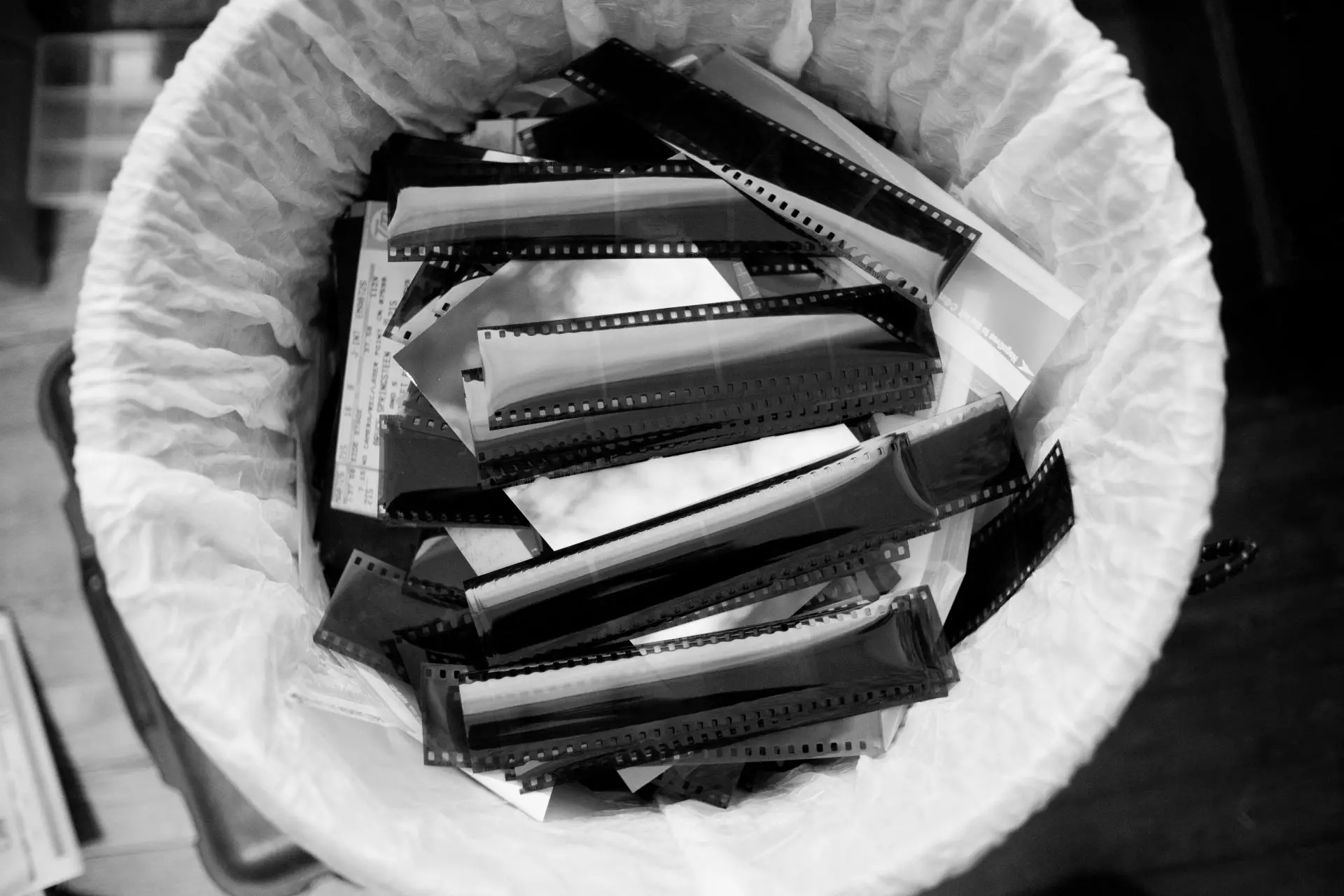








Comments
Jeff on Scan and Destroy – My blasphemous quest to be free of my negatives – By Max Cooper
Comment posted: 20/12/2022
Doug on Scan and Destroy – My blasphemous quest to be free of my negatives – By Max Cooper
Comment posted: 20/12/2022
https://en.wikipedia.org/wiki/Digital_obsolescence
"Digital obsolescence is the risk of data loss because of inabilities to access digital assets, due to the hardware or software required for information retrieval being repeatedly replaced by newer devices and systems, resulting in increasingly incompatible formats.
"
Comment posted: 20/12/2022
Comment posted: 20/12/2022
brian m cox on Scan and Destroy – My blasphemous quest to be free of my negatives – By Max Cooper
Comment posted: 20/12/2022
Jan on Scan and Destroy – My blasphemous quest to be free of my negatives – By Max Cooper
Comment posted: 20/12/2022
JK Lockwood on Scan and Destroy – My blasphemous quest to be free of my negatives – By Max Cooper
Comment posted: 20/12/2022
Mark O'Brien on Scan and Destroy – My blasphemous quest to be free of my negatives – By Max Cooper
Comment posted: 20/12/2022
Kevin on Scan and Destroy – My blasphemous quest to be free of my negatives – By Max Cooper
Comment posted: 20/12/2022
Keeping all my negs (particularly color) make very little sense to me; paranoia as you say. Keeping the negs for keepers is tolerable but it would easily fit in one envelope. I had some of dad's Kodachromes digitally printed and mounted at my local drug store and they look great; different from analog but great.
I think anyone who hoards their negs are going to get what most of my cousins are doing with their parents collection: getting someone to scan the ones they remember and after 2-10 attempts at sorting it out throw it away because they don't want to leave the mess to their kids.
davesurrey on Scan and Destroy – My blasphemous quest to be free of my negatives – By Max Cooper
Comment posted: 20/12/2022
One of the best, most interesting and entertaining articles I’ve read on here for a long time. Thank you.
@Doug,
I love music but a few years ago I realised my collection was scattered on vinyl, Philips cassettes, DAT, Mini-Discs and CDs. It took up space and I also needed the hardware to play all of it. It now all resides on my music server where I can search by artist/album/whatever and listen to it in different rooms around the house. And it’s all backed up in case of disasters.
Similarly I had negatives, slides, prints in boxes, all of it stored away and hardy ever opened. So I digitised the lot. Now they are on my server and I can see them at the touch of a button or copy them to friends and relatives. Again all backed up. What’s there not to like?
The fact that I no longer have my vinyl or cassettes doesn’t cause me any issues and nor does the loss of the negatives and slides.
Ted Ostrowski on Scan and Destroy – My blasphemous quest to be free of my negatives – By Max Cooper
Comment posted: 20/12/2022
Art Meripol on Scan and Destroy – My blasphemous quest to be free of my negatives – By Max Cooper
Comment posted: 20/12/2022
Röd White on Scan and Destroy – My blasphemous quest to be free of my negatives – By Max Cooper
Comment posted: 21/12/2022
Food for thought indeed, thank you for taking the time to write such a thought provoking article.
Comment posted: 21/12/2022
Jay Dann Walker on Scan and Destroy – My blasphemous quest to be free of my negatives – By Max Cooper
Comment posted: 22/12/2022
Some years ago, maybe in the throes of just-post retirement PTSD attack, I too quite seriously considered destroying most of the hoard of really old negatives I have so lovingly hung on to over the past half century, including three major overseas moves involving near-total downsizing and new starts in almost everything, as well as so many more regional and local moves to new digs. Somehow my stash of images made it safely from North America to southeast Asia to Australia without any major crises and hardly any deterioration, not even in my ancient Agfachromes (tho' sadly most of my Ektachrome and the ancient Fujicolor did not fare quite so well and some age-related fading is now appearing) which I mostly had processed in a color lab in Bangkok, quite expecting them to have faded beyond recognition in a handful of years. Not so. Only the hundred or so Afga slide rolls I unwisely had processed in a Indonesian Chinese (supposedly) prolog in Surabaya in the late '90s have now all but vanished from my vision. I had to put in a couple of really hard years from 2012 to save as many as I could, scanned digitally. Here I quite agree with Hamish that with a well-thought out plan, digital archives can be safely maintained and kept for decades. Whether or not those dici-images will last into the 22nd century - and come to think of it, will we as a global race? The jury is really out on that one and I happen to think it will be a good thing that I probably won't be around after say 2030 to see the massive deterioration in our quality of life, but enough said about this - remains a moot point. I hope they will. Even mine, as inconsequential as most of them may be. I mean, cat portraits, anyone? I have thousands!
Now, I could go on about this for reams of writing, but let's move on. My family images were given the first treatment and even my childhood portraits (dating back to 1952 and printed on the infamous old Kodak Ektacolor paper, it seems legendary for its quick fading, but no, mine as as good as they were the day they were enlarged). I have them all in archival paper with paper covers in a hideously expensive acid-free albums, for future generation of my relations to view (or more likely ignore).
My thousands of cat shots were then sorted, keywords, scanned and mostly cut up. I mean, who will want to see candids of sleeping felines in the next century? Not even now - and not even me. But the memories endure.
From 1970 until the sad proliferation of online digicrap images flooded the world, I shot stock, and did well both artistically and financially from this. I have portfolios of Bali taken in 1970, 1972, 1974 and 1975, mostly on Tri-X with believe it or not, a Kodak Retina, published in many Europe and North America. Try giving away any image however good of Bali in the day and age, and you'll get my point. Ditto Europe in the '70s, mostly Asia from the '80s, a lot of architectural work from 1990 when I shifted careers from journalism to interior design and got seriously interested in old colonial buildings. Who would want these images now, well, the door remains open on this - I've contacted archives to negotiate sales (at very reasonable fees), mostly in Europe where the curators and historians still have respect for old buildings, but so far to no avail.
For now, for the time being, I have all these analog images stored in several metal filing cabinets in a secure room - okay, our second bedroom, aka my home darkroom and junk storage area, but weather-sealed and temperature-controlled. NO WAY will I even entertain the thought of destroying them for now - tho' I remain haunted by the realization that when I'm but a memory, my executor, long-suffering partner or other family members may make the hard decision for me, and order in a hopper... but by then I will be past caring and beyond controlling the situation, so it isn't really 's a (major) concern.
Yet sometimes in the night I wake up and...
Okay, I've depressed far too much on this, and poor Max may be faced with a comment much the same length as his most excellent article. So I'll stop.
The conundrum for me is, while we have a certain responsibility to family (and in a lesser extent to posterity) to preserve our images for future generations, what is the best way to go about ensuring that our negatives, slides and digital shots stay in as pristine a condition as we can keep them?
This last point, I think, may be worthy of 35mmc articles in future - from far better writers than I am.
Apologies for the length of all this, and many thanks for taking the time to read it. And my very best wishes to Max for many more of the same sort of quality articles in future.
Dann in Melbourne, Australia
Jay Dann Walker on Scan and Destroy – My blasphemous quest to be free of my negatives – By Max Cooper
Comment posted: 22/12/2022
Again, this could be me. I went thru exactly your situation back in the '80s, when my then 70 year old mother started showing signs of the dementia which not many years later would mentally completely disable her and make life for my other siblings in Canada a misery. She took to destroying many items of interest and value to other family members, notably my original birth and adoption certificates (I'm an "acquired" child), school records, old family photos and whatever she found at home on days when her brain was wildly malfunctioning.
I went back to Canada from Australia in 1982 and realizing what was about to happen, took possession of as many surviving photos and negatives (mostly from a 616 Kodak Box Brownie my stepdad bought in 1943 when they were married) which I took back to Sydney with me. I've now scanned them and sent digital images to my surviving brother and sisters, all of which were greatly appreciated and enjoyed. Mom passed away in 2021, age 101 and 11 months, after decades of mental and physical activity. So the memories survive.
Rod, please consider that I say what follows with the utmost respect and sincerity, but looking after all your family visual treasures will give you something to fill in your time. Assuming you are somewhere near my age (70s), retired, and maybe with time on your hands. Your legacy is to do what you intend to do properly, and I agree with you in almost everything you said except for one thing - whatever you do, please do NOT destroy the original negatives and prints, but keep them for another family member who may want them in the future. This may be a niece or nephew who is only a child today. They will be most grateful to you for this. Think of the future, not your present (minor) discomfort in storing all that material.
As I wrote previously, there is ample material here for several good articles. I truly hope a few of the fine writers here in 35mmc will pick up the idea and go with it.
Dann in Melbourne, Australia
Jay Dann Walker on Scan and Destroy – My blasphemous quest to be free of my negatives – By Max Cooper
Comment posted: 22/12/2022
Again, this could be me. I went thru exactly your situation back in the '80s, when my then 70 year old mother started showing signs of the dementia which not many years later would mentally completely disable her and make life for my other siblings in Canada a misery. She took to destroying many items of interest and value to other family members, notably my original birth and adoption certificates (I'm an "acquired" child), school records, old family photos and whatever she found at home on days when her brain was wildly malfunctioning.
I went back to Canada from Australia in 1982 and realizing what was about to happen, took possession of as many surviving photos and negatives (mostly from a 616 Kodak Box Brownie my stepdad bought in 1943 when they were married) which I took back to Sydney with me. I've now scanned them and sent digital images to my surviving brother and sisters, all of which were greatly appreciated and enjoyed. Mom passed away in 2021, age 101 and 11 months, after decades of mental and physical activity. So the memories survive.
Rod, please consider that I say what follows with the utmost respect and sincerity, but looking after all your family visual treasures will give you something to fill in your time. Assuming you are somewhere near my age (70s), retired, and maybe with time on your hands. Your legacy is to do what you intend to do properly, and I agree with you in almost everything you said except for one thing - whatever you do, please do NOT destroy the original negatives and prints, but keep them for another family member who may want them in the future. This may be a niece or nephew who is only a child today. They will be most grateful to you for this. Think of the future, not your present (minor) discomfort in storing all that material.
As I wrote previously, there is ample material here for several good articles. I truly hope a few of the fine writers here in 35mmi will pick up the idea and go with it.
Okay more than enough (= far too much) said by me about this. No more!
Dann in Melbourne, Australia
Jay Dann Walker on Scan and Destroy – My blasphemous quest to be free of my negatives – By Max Cooper
Comment posted: 22/12/2022
In my last post - "Mom passed away in 2021, age 101 and 11 months, after decades of mental and physical activity. So the memories survive."
I meant to write at the close of all this, "...after decades of mental and physical Inactivity..."
No more. As we say in Quebec, from me, c'est tout.
Dann in Melbourne
Bill Brown on Scan and Destroy – My blasphemous quest to be free of my negatives – By Max Cooper
Comment posted: 22/12/2022
Before phone cameras, which virtually no one ever prints images from, film was the every day way to document the world around us. I see all of us film luddites as bridges to the past and keepers of not just our personal history but also the history of our own personal world. I know I'm cut from a different piece of cloth but I'm interested in history beyond my own. Seeing images from recent past to 100 years ago enriches my life. I feel honored to be able to participate in the preservation and restoration of family histories. I guess you can call personal archives narcissistic but I see it more as my gift to future individuals that I will probably never meet. I took time out of the busy hustle and bustle of life to photograph _______. You fill in the blank. I see it as not just stopping to smell the roses but also photographing that rose. A rose that wilted and died shortly after. I see my neg or tranni as a way to stop and smell that rose again or remember the fragrance of my dear mom.
You go your way and I'll go mine.
Matt L. on Scan and Destroy – My blasphemous quest to be free of my negatives – By Max Cooper
Comment posted: 27/12/2022
Slightly off-topic, but can you post a link to your photo-retouching website, or your business email address?
I have some retouching I need on a few scans i just had done, and w/ your speciality in restoration I’m wondering if u might be the guy to do it. Basically I recently shot a roll of 6x6 B&W up in the Sierras w/ a new (old) medium format camera I just got, and despite my careful inspection it produced visible light-leaks on frames that I’d like to have removed/corrected. The frames have already been professionally high-rez scanned and corrected in Lightroom (and were properly exposed and processed to begin with) but of course the light-leaks are still visible in the scans, and need to be layer-masked and corrected in PS to be less noticeable, and frankly I’m a bit out of practice, and so I thought I’d see what you’d charge to fix them.
Anyway please post your business contact info, and i’ll reach out to you for a quote.
Thanks Much,
Matt
Comment posted: 27/12/2022
Comment posted: 27/12/2022
Sulio Pulev on Scan and Destroy – My blasphemous quest to be free of my negatives – By Max Cooper
Comment posted: 29/12/2022
1. There are digital obsolescence or Digital dilemma as formulated by ASC American Society of cinematographers. Its a serious problem.
2. Digitization technologies develop and with every next round of development its reveal more and more details from the same negative. And better and better color rendering. But we still far from complete digitization. So we need to keep negatives as long as possible.
3. There are new media - quartz disk that last more than 10 000 years and can hold both digital and abalog info/text/picture. But it's still in the lab and with slow writing capabilities.
4. In the western shitty countries as far as I know visual archives arw very appreciated and its a kind of crime to destroy visual originals.
5. Greed for money in the bull$#1t west is notorious and I cannot understand why you don't make money from that.
6. Only deep amateurs have your way of thinking, so please stay at your amateur level and do not try to involve in professional world. Fotoreporter for local news paper and/or small village site, wedding photographer or portret photobooth for ID cards and passports, as well as publishing in western shitty media as Facebook, Instagram and similar do not make you Profesional despite your dreams and wishes.
Comment posted: 29/12/2022
Comment posted: 29/12/2022
Comment posted: 29/12/2022
Comment posted: 29/12/2022
Comment posted: 29/12/2022
Comment posted: 29/12/2022